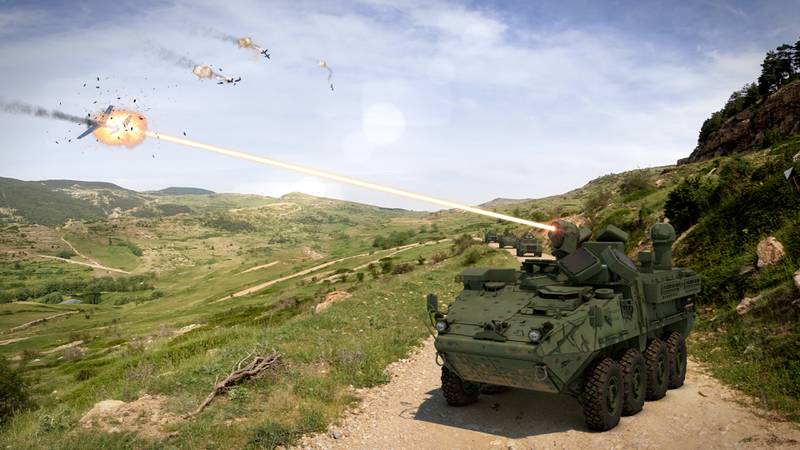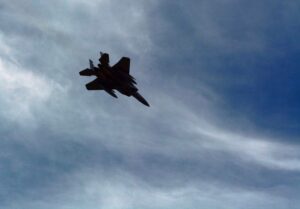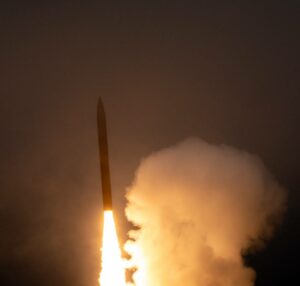WASHINGTON — Five Pelican dropships and two Phantom troop carriers glide into view near snowcapped hills on a world with biomes similar to Earth’s. A handful of the warplanes break formation, ultimately bound for farther-flung targets, as volleys of neon green anti-aircraft fire erupt.
Despite some dodging, the fire proves accurate, and one of the Pelicans is hit. It veers violently forward and smacks into another just in front. A cry for help is heard; then, an explosion. A voice over the radio warns of the dicey disembark to come.
“Brace yourselves.”
And, as players of Bungie’s smash-hit video game “Halo 3″ regain control of Master Chief Petty Officer John-117, the virtual super-soldier hoists to his shoulder what millions of gamers have affectionately nicknamed the “Spartan Laser,” a hulking, fearsome weapon powered by futuristic battery cells.
When primed with a squeeze and hold of the controller’s trigger, the device unleashes a blast of directed energy capable of devastating multiple targets, virtual infantry and armored opponents. Heat management forces downtime between shots, a nod to the realities that often limit fire in real weapons.
While such immensely powerful devices have long been a staple of computer games, movies and science-fiction novels, success in fielding practical weapons that can zap targets on real-world battlefields has eluded governments, scientists and defense contractors for more than a half-century. At least until recently.
“The hundreds of systems in the field? It’s coming,” Andy Lowery, the chief operating officer of defense company Epirus, a developer of directed-energy and counter-drone systems, said in an interview. “You’ll see tens of billions of dollars, I think, being applied once we get into production, manufacturing and then operations and sustainment.”
State of play
The U.S. Department of Defense is spending an average $1 billion a year on developing directed-energy weapons with the goal of using them to defeat threats including drones and missiles. It requested at least $669 million in fiscal 2023 for unclassified research, testing and evaluation and another $345 million for unclassified procurement, the Congressional Research Service reported.
Under Secretary of Defense for Research and Engineering Heidi Shyu included directed energy on a list of 14 critical and emerging defense technologies released in February 2022.
Potential applications abound. High-energy lasers, HEL, and high-power microwave, HPM, systems can be used for short-range air defense, SHORAD, and to counter unmanned aerial systems, C-UAS, as well as rockets, artillery and mortars, C-RAM.
“What does a laser do to impart damage on the set target, utilizing directed energy? It just basically heats up and melts, right? Just a ton of energy. There’s no, really, wave interaction,” Lowery said. “With HPM, you’re actually trying to use the electro-magnetics in the air to cease the ability for anything that uses voltage and current to work, and you’re trying to do that as efficiently as possible, because it’s not easy.”
The weapons now in development come mainly in two forms: high-energy lasers, like Rafael’s Iron Beam, and Epirus’ HPMs. The former focuses a beam or beams of energy to blind, cut or inflict heat damage on a target. The latter unleashes waves of energy that overwhelm or fry electronic components.
Each has its respective strengths and weaknesses.
While HPMs can have a near-instant effect on electronic guts, its efficacy is stunted at greater ranges. And while high-energy lasers can punch holes through all sorts of material, certain atmospheric conditions including fog or wind can impede or distort the shot. Neither needs to be mechanically reloaded, like a rifle or tank, but they are reliant on power production and output, which can be disrupted.
“In very controlled conditions, they seem to perform as they should,” Thomas Withington, an analyst and author specializing in electronic warfare and military communications, said in an interview. The issue, though, is “how do you translate that to the front line in Ukraine?”
Testing, testing
The U.S. Army, Air Force, Navy and Marine Corps are all, right now, attempting to fold directed-energy systems into offensive and defensive capabilities.
The Pentagon’s Joint Counter-Small Unmanned Aircraft Systems Office and the Army’s Rapid Capabilities and Critical Technologies Office in June tapped five companies to demonstrate weaponry capable of taking down one-way attack drones. The get-together at Yuma Proving Ground in Arizona featured a Lockheed Martin-made Mobile Radio Frequency-Integrated UAS Suppressor, or MORFIUS, a tube-launched, fixed-wing drone that flies at a target and lets loose a high-power microwave pulse.
The service months earlier awarded a $66 million deal to Epirus for prototypes of its drone-zapping Leonidas device. The tech has since been paired with the Anduril Industries Lattice command-and-control program for the Marine Corps and DroneShield’s sensing-and-jamming DroneSentry system.
Similarly, the Air Force in April tested its Tactical High-power Operational Responder, or THOR, at Kirtland Air Force Base’s Chestnut Test Site in New Mexico. The system looks like a shipping container with a satellite dish welded to the top; its effects, however, are less innocuous.
Adrian Lucero, a program manager at the Air Force Research Laboratory’s directed energy directorate, in a statement at the time of testing said THOR “was exceptionally effective at disabling” its targets. The lab employs approximately 11,500 military, civilian and contractor personnel, and manages a $7 billion portfolio.
“The THOR team flew numerous drones at the THOR system to simulate a real-world swarm attack,” Lucero said. “THOR has never been tested against these types of drones before, but this did not stop the system from dropping the targets out of the sky with its non-kinetic, speed-of-light high-power microwave” pulses.
In December 2021, the Navy announced the successful testing of a high-energy laser aboard the USS Portland while it sailed through the Gulf of Aden. A previous test was done in May 2020, during which a small drone was disabled over the Pacific Ocean.
The service has been at the forefront of trying to deploy practical directed-energy weapons. Both Lockheed’s High Energy Laser with Integrated Optical-dazzler and Surveillance, or HELIOS, and the in-house Optical Dazzling Interdictor Navy, or ODIN, to tackle small boats and intelligence-gathering systems, have been installed aboard destroyers.
RELATED

“As the technology moves forward, it will be a technology that is adopted for certain niches. Perhaps ship defense against anti-ship missiles, counter-drone, that kind of thing,” Withington said. “Will it become a replacement for the anti-ship missile? Would it be something that you can sling under the belly of a B-21 and vaporize an air ministry in downtown Damascus? I don’t know. I’m inclined to think in the short- to medium-term probably not.”
A dazzling future
There is often a long lag between the development of technology and its implementation and procurement, a period of time known as the “valley of death” among those in the defense community. Lately, military leaders are voicing a greater sense of urgency about the need to get these systems fully built and deployed.
When asked about directed-energy weapons at a National Defense Industrial Association conference last month, Navy Adm. John Aquilino had two words for investors and builders: “Bring it.”
Aquilino serves as the top man in the Indo-Pacific, a region the Biden administration considers vital to international security and financial well-being. His remit includes China and North Korea, as well as allies Australia, Japan and South Korea.
“I’m very encouraged by the high-energy laser capability that’s being experimented with and utilized,” Aquilino said at the time. The key? Acceleration.
“If that capability exists, and we can deliver in 18 to 24 months, I’m ready to plug it in,” Aquilino said. “I’m ready to experiment with it tomorrow. I’ve got the largest test range on the globe.”
Some big names are digging in: Booz Allen Hamilton last year announced the establishment of a high-energy laser division dubbed HELworks. The defense consultancy unveiled three product lines at the time including a High Energy Laser Mission Equipment Package meant for the Army’s Stryker combat vehicle.
“Between one and five years, you’re going to see an exiting of the AoA, of the analysis of alternatives, and then entering into programs of record,” Lowery said. “And that is going to mark a much bigger spend.”
International markets are also heating up. The U.K. and France are particularly interested in directed energy.
Raytheon UK, a division of RTX, plans to integrate a high-energy laser onto a Wolfhound armored vehicle. During four days of testing in the U.S., the laser system “successfully acquired, tracked, targeted and destroyed dozens of” drones, according to the company, which is opening an advanced laser integration center in Scotland.
And while militaries may be many years away from fielding anything like the fictional, shoulder-mounted Spartan Laser, the technology now being developed is proving itself too important to ignore, according to experts.
“Everybody thinks it’s laser guns and death rays,” Withington said. “I would say there won’t be a ‘Big Bang,’ but it should probably be a ‘Big Zap’ for directed energy weapons.”
Colin Demarest is a reporter at C4ISRNET, where he covers military networks, cyber and IT. Colin previously covered the Department of Energy and its National Nuclear Security Administration — namely Cold War cleanup and nuclear weapons development — for a daily newspaper in South Carolina. Colin is also an award-winning photographer.
- SEO Powered Content & PR Distribution. Get Amplified Today.
- PlatoData.Network Vertical Generative Ai. Empower Yourself. Access Here.
- PlatoAiStream. Web3 Intelligence. Knowledge Amplified. Access Here.
- PlatoESG. Carbon, CleanTech, Energy, Environment, Solar, Waste Management. Access Here.
- PlatoHealth. Biotech and Clinical Trials Intelligence. Access Here.
- BlockOffsets. Modernizing Environmental Offset Ownership. Access Here.
- Source: https://www.defensenews.com/battlefield-tech/2023/09/18/directed-energy-weapons-making-jump-from-sci-fi-to-real-world/
- :has
- :is
- :not
- :where
- $UP
- 1
- 10
- 11
- 14
- 2020
- 2021
- 2022
- 2023
- 24
- 500
- 70
- 9
- a
- ability
- About
- acceleration
- According
- accurate
- acquired
- actually
- administration
- adopted
- advanced
- against
- AIR
- Air Force
- aircraft
- All
- also
- alternatives
- among
- an
- analysis
- analyst
- and
- announced
- Another
- anything
- applications
- applied
- approximately
- April
- ARE
- arizona
- Army
- AS
- Association
- At
- atmospheric
- attack
- attempting
- Australia
- author
- average
- award-winning
- awarded
- away
- Basically
- battery
- BE
- Beam
- because
- become
- been
- before
- being
- between
- biden
- Biden Administration
- Big
- bigger
- Billion
- billions
- blind
- both
- bound
- Break
- builders
- built
- but
- by
- CAN
- capabilities
- capability
- capable
- Carolina
- carriers
- Cells
- Center
- certain
- chief
- Chief Operating Officer
- China
- cold
- combat
- come
- coming
- Commons
- Communications
- community
- Companies
- company
- components
- computer
- conditions
- Conference
- Congressional
- considers
- consultancy
- Container
- Contractor
- contractors
- control
- controlled
- could
- Counter
- covered
- covers
- critical
- Current
- Cut
- cyber
- daily
- damage
- Days
- Death
- December
- december 2021
- Defense
- defensive
- deliver
- demonstrate
- Department
- department of defense
- Department of Energy
- deploy
- deployed
- destroyed
- devastating
- developed
- Developer
- developing
- Development
- device
- Devices
- DID
- directed
- disabled
- dish
- displayed
- Division
- do
- does
- dollars
- donald
- done
- Dont
- down
- downtime
- Downtown
- dozens
- drone
- Drones
- Dropping
- dubbed
- during
- Earlier
- easy
- effect
- Effective
- effects
- efficacy
- efficiently
- Electronic
- emerging
- employs
- encouraged
- energy
- Engineering
- entering
- equipment
- establishment
- evaluation
- exceptionally
- exists
- Exiting
- experiment
- experts
- explosion
- false
- featured
- February
- fictional
- field
- financial
- financial well-being
- Fire
- fires
- Fiscal
- five
- floating
- focuses
- Fog
- For
- For Investors
- Force
- Forces
- forefront
- formation
- Former
- forms
- Forward
- four
- from
- front
- fully
- futuristic
- Gamers
- Games
- GAO
- get
- globe
- goal
- going
- got
- Governments
- greater
- Green
- Ground
- GUNS
- had
- Hamilton
- handful
- harbor
- Have
- he
- heard
- help
- High
- Hills
- his
- Hit
- hold
- Holes
- How
- However
- http
- HTTPS
- Hundreds
- i
- image
- images
- immensely
- implementation
- important
- in
- Inclined
- included
- includes
- Including
- Incoming
- industrial
- industries
- inflict
- integrate
- integrated
- integration
- interaction
- interested
- International
- Interview
- into
- Investors
- issue
- IT
- ITS
- itself
- Japan
- John
- joint
- jpg
- jump
- june
- just
- Key
- Kind
- Know
- known
- korea
- lab
- largest
- laser
- lasers
- Last
- Last Year
- leaders
- least
- less
- Lets
- like
- LIMIT
- Line
- lines
- List
- Long
- Look
- LOOKS
- mainly
- Making
- man
- management
- manager
- manages
- manufacturing
- many
- Marine
- mark
- Markets
- Maryland
- master
- May..
- meant
- Mexico
- militaries
- Military
- million
- millions
- ministry
- missiles
- Mission
- Mobile
- model
- Month
- months
- more
- moves
- Movies
- much
- multiple
- namely
- names
- National
- Near
- Need
- needs
- Neither
- Neon
- networks
- never
- New
- no
- North
- North Korea
- now
- nuclear
- Nuclear weapons
- numerous
- ocean
- of
- offensive
- Office
- Officer
- often
- on
- once
- ONE
- opening
- operating
- operational
- Operations
- opponents
- or
- out
- output
- over
- Pacific
- Pacific Ocean
- package
- paired
- particularly
- perform
- perhaps
- period
- Personnel
- phantom
- photo
- photographer
- plans
- plato
- Plato Data Intelligence
- PlatoData
- players
- plug
- portfolio
- Portland
- possible
- power
- powered
- powerful
- Practical
- previous
- previously
- probably
- procurement
- Product
- Production
- Program
- Programs
- protagonist
- prototypes
- proves
- proving
- pulse
- punch
- Radio
- range
- rapid
- ready
- real
- real world
- realities
- really
- recently
- record
- regain
- region
- released
- replacement
- Reported
- reporter
- requested
- research
- respective
- right
- rtx
- s
- Said
- satellite
- say
- sci-fi
- scientists
- Scotland
- Screen
- secretary
- security
- see
- seem
- sense
- Sense of Urgency
- Series
- serves
- service
- set
- Shipping
- shot
- shots
- should
- similar
- since
- site
- sky
- small
- some
- something
- South
- South carolina
- South Korea
- Space
- Spartan
- specializing
- spend
- Spending
- Squeeze
- Staff
- Statement
- Stop
- strengths
- stryker
- success
- successful
- such
- surveillance
- Swarm
- system
- Systems
- tackle
- tactical
- taking
- tank
- Tapped
- Target
- targeted
- targets
- team
- tech
- Technologies
- Technology
- tens
- test
- tested
- Testing
- than
- that
- The
- Them
- then
- There.
- These
- they
- thing
- think
- Thinks
- this
- those
- though?
- threats
- three
- Through
- time
- to
- tomorrow
- Ton
- too
- top
- translate
- trigger
- trying
- two
- types
- u.s.
- U.S. Department of Defense
- Uk
- Ukraine
- Ultimately
- under
- unleashes
- until
- unveiled
- urgency
- use
- used
- uses
- using
- utilized
- Utilizing
- vehicle
- very
- via
- Video
- View
- Virtual
- vital
- Voice
- Voltage
- war
- Warns
- Warplanes
- was
- Wave
- waves
- we
- Weapons
- WELL
- What
- which
- while
- will
- wind
- with
- words
- Work
- world
- would
- year
- years
- you
- zephyrnet












